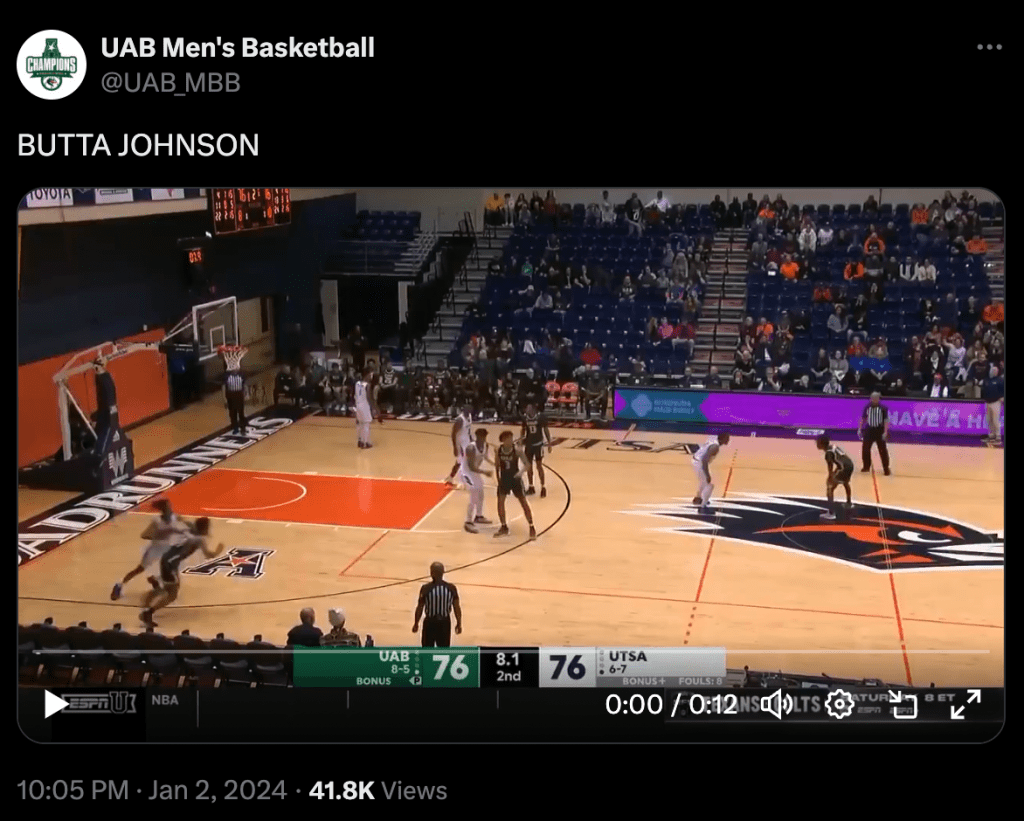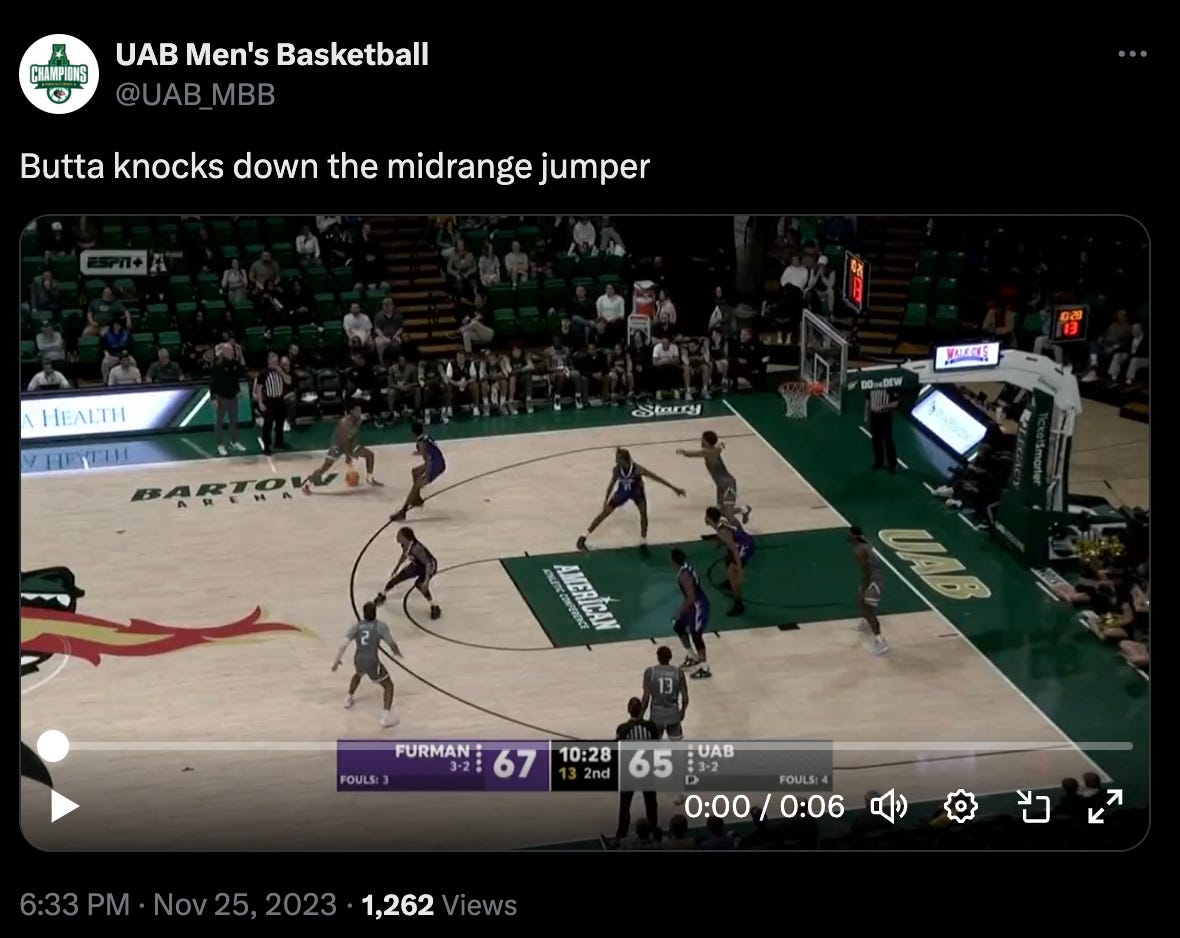All charts and data courtesy of CBBAnalytics.com.
Efrem "Butta" Johnson has officially arrived.
On Tuesday night, the sophomore guard stunned the UTSA Roadrunners with an ice-cold, buzzer-beating turnaround jumper. It was glaringly obvious that Butta would take the last shot: at the time of the final possession, Johnson had scored eight consecutive UAB points. It was a telegraphed punch, a truth as inevitable as self-righteous Memphis fans.
It was also completely unstoppable.
After two late Jordan Ivy-Curry free throws tied the game, the Blazers inbounded the ball with the shot clock turned off. As expected, Eric Gaines meandered up the court, wasted a few seconds, and fired a pass to the Huntsville native. As Butta rotated around a Yaxel Lendeborg screen, Roadrunner guard Christian Tucker whirled past the three-point line, desperately trying to keep pace with Johnson. He admirably contested the midrange jumper that would sink his team. It didn't matter.
The dagger gave Johnson his 16th and 17th points of the game, one away from a career-high. When the final horn sounded, Butta had made seven of his eleven field goal attempts, good for a scintillating 63.6 FG%. On a night when the Blazers were sloppy on both ends of the court, Johnson's consistency and poise were invaluable. His efforts, alongside a monstrous performance from Yaxel Lendeborg, almost single-handedly secured UAB's inaugural AAC win.
After the game, a UTSA fan asked me why the Blazers were so eager to give Johnson the final shot. Why not the talented Gaines, the dominant Lendeborg, or the proven clutch hero Daniel Ortiz?
As mentioned before, Johnson ended the game on a serious tear - he scored the Blazers' final ten points, including six in the last two minutes. But Andy Kennedy didn't put the game in Butta's hands because of a simple hot streak. Johnson has become truly fearsome from the field this season, a shining beacon amid UAB's shooting woes.
As ardent viewers of the team could guess, Johnson has done most of his damage from the midrange. In this context, I'm defining "midrange" as the highlighted areas above: all two-pointers outside of the restricted area.
Butta has attempted 29 twos outside the paint, making 13 of them. That's good for a 44.8% shooting percentage, 9.1 percentage points higher than the Division 1 mean. He excels on shots that are traditionally considered analytically inferior. Johnson hits 15-foot turnarounds, contested elbow jumpers, and deep pull-up twos at a higher rate than any other Blazer. Consider this tough shot against Drake:
And this contested pull-up against Clemson:
The majority of his field goal attempts come from this range. If it ain't broke, don't fix it.
He's been even more accurate on shots in the lane: Butta is converting midrange attempts inside the paint at a whopping 63.6% clip. Much of this, obviously, is small sample size - he's taken just 11 - but it'd be doing Johnson a disservice to brush off this high percentage as a simple case of favorable variance. Butta's shot selection has been excellent; he knows which shots he's capable of making, even if they appear difficult. Take this turnaround jumper against Furman:
In total, Johnson has made 20 of his 40 midrange attempts, an even 50% clip. Over a full season, that would be the highest percentage of any Blazer guard since at least 2018, when CBBAnalytics data ends. Tavin Lovan's 2021 and 2022 seasons, where he shot 46.2% and 44.7%, respectively, are the only comparable performances.
The campaign is long, of course, and we're not even halfway through it. Shooting has proven highly volatile for this team, and slight regression likely lies in the wings for Butta. However, we've reached conference play, and Johnson's midrange prowess has yet to decline - in fact, it's been trending upwards as of late.
Butta's most eye-popping box stat is his impressive 40.5% clip from beyond the arc. Despite Johnson having already attempted more triples than he did the entirety of last season, his three-point percentage has risen by over four points. Much of this improvement stems from his excellence on corner triples: Butta has taken 14 of them and has made eight. To put that into perspective, Johnson makes corner threes at a higher rate (57.1%) than Eric Gaines makes shots at the rim (54.2%).
That's an appreciation of Butta's consistency, not a shot at Gaines. 57.1% is certainly unsustainable, but he's already doubled the number of corner threes he made all of last year.
Johnson is an adequate shooter from above the break, converting at a 32.1% clip. That's nothing special - it's almost precisely the Division 1 average - but it leads all UAB guards by over two points. That speaks volumes about this team's struggles from the field. Butta's seemingly mediocre 32.1% does not exist in a vacuum - it is made much more valuable by the lack of shooters around him.
The only Blazer outpacing Johnson from above the break is Yaxel Lendeborg, shooting 41.7%, buoyed by his likely irreplicable 5/6 performance against UTSA.
For those uninitiated, eFG% is a statistic that gives three-pointers more weight than two-pointers. It's one of the most effective and popular ways to evaluate shooting performance. Johnson's eFG% is 54.7%, the highest of any guard on the team and 350th-highest of any player in the nation. TS% is a similar statistic that also incorporates free-throw percentage. Johnson's TS% is 57.2%, again the highest of any UAB guard and again top-430 in the nation.
Butta has room to improve, of course. I haven't mentioned his shooting percentage inside the restricted area for a reason - Johnson has made just 50% of his shots at the rim, 12.1 percentage points below the D1 mean. He struggles to draw fouls and rarely shows up in the box score defensively: his block and steal rates are negligible.
However, his marked strides have substantially helped the Blazers. For the first couple weeks of the season, UAB was drowning in bricks, ranking near the bottom of every team shooting leaderboard. The roster as a whole has begun to experience slight positive regression, but the Blazers are still prone to devastating scoring droughts. It cannot be overstated how important it is to have a player like Johnson, someone who can nail crucial threes and consistently manufacture points with tough interior shots.








